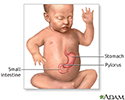Pyloric stenosis in infants
Congenital hypertrophic pyloric stenosis; Infantile hypertrophic pyloric stenosis; Gastric outlet obstruction; Vomiting - pyloric stenosisPyloric stenosis is a narrowing of the opening from the stomach into the small intestine. This is called the pylorus. This article describes the condition in infants.
Causes
Normally, food passes easily from the stomach into the first part of the small intestine through a valve called the pylorus. With pyloric stenosis, the muscles of the pylorus are thickened. This prevents the stomach from emptying into the small intestine.
The exact cause of the thickening is unknown. Genes may play a role, since children of parents who had pyloric stenosis are more likely to have this condition. Other risk factors include:
- Certain antibiotics
- Too much acid in the first part of the small intestine (duodenum)
Small intestine
The duodenum is the first part of the small intestine. It is located between the stomach and the middle part of the small intestine, or jejunum. Aft...
 ImageRead Article Now Book Mark Article
ImageRead Article Now Book Mark Article - Certain diseases a baby is born with, such as diabetes
Pyloric stenosis occurs most often in infants younger than 6 months. It is more common in boys than in girls.
Symptoms
Vomiting is the first symptom in most children:
- Vomiting may occur after every feeding or only after some feedings.
- Vomiting usually starts around 3 weeks of age, but may start any time between 1 week and 5 months of age.
- Vomiting is forceful (projectile vomiting).
- The infant is hungry after vomiting and wants to feed again.
Other symptoms appear several weeks after birth and may include:
- Abdominal pain
- Burping
- Constant hunger
-
Dehydration (gets worse as vomiting gets worse)
Dehydration
Dehydration occurs when your body does not have as much water and fluids as it needs. Dehydration can be mild, moderate, or severe, based on how much...
 ImageRead Article Now Book Mark Article
ImageRead Article Now Book Mark Article - Failure to gain weight or weight loss
- Wave-like motion of the abdomen shortly after feeding and just before vomiting occurs
Exams and Tests
The condition is often diagnosed before the baby is 6 months old.
A physical exam may reveal:
- Signs of dehydration, such as dry skin and mouth, less tearing when crying, and dry diapers
- Swollen belly
- Olive-shaped mass when feeling the upper belly, which is the abnormal pylorus
Ultrasound of the abdomen may be the first imaging test. Other tests may include:
Ultrasound of the abdomen
Abdominal ultrasound is a type of imaging test. It is used to look at organs in the abdomen, including the liver, gallbladder, pancreas, and kidneys...

-
Barium x-ray -- reveals a swollen stomach and narrowed pylorus
Barium x-ray
An upper GI and small bowel series is a set of x-rays taken to examine the esophagus, stomach, and small intestine. Barium enema is a different test ...
 ImageRead Article Now Book Mark Article
ImageRead Article Now Book Mark Article - Blood tests -- often reveal an electrolyte imbalance
Electrolyte
Electrolytes are minerals in your blood and other body fluids that carry an electric charge. Electrolytes affect how your body functions in many ways...
Read Article Now Book Mark Article
Treatment
Treatment for pyloric stenosis involves surgery to widen the pylorus. The surgery is called pyloromyotomy.
In infants who cannot have surgery, tube feeding or medicine to relax the pylorus is tried.
Outlook (Prognosis)
Surgery usually relieves all symptoms. As soon as several hours after surgery, the infant can start small, frequent feedings.
Possible Complications
If pyloric stenosis isn't treated, a baby won't get enough nutrition and fluid. The child can become underweight and dehydrated.
When to Contact a Medical Professional
Contact your health care provider if your baby has symptoms of this condition.
References
Kliegman RM, St. Geme JW, Blum NJ, Shah SS, Tasker RC, Wilson KM. Pyloric stenosis and other congenital anomalies of the stomach. In: Kliegman RM, St. Geme JW, Blum NJ, Shah SS, Tasker RC, Wilson KM, eds. Nelson Textbook of Pediatrics. 21st ed. Philadelphia, PA: Elsevier; 2020:chap 355.
Seifarth FG, Soldes OS. Congenital anomalies and surgical disorders of the stomach. In: Wyllie R, Hyams JS, Kay M, eds. Pediatric Gastrointestinal and Liver Disease. 6th ed. Philadelphia, PA: Elsevier; 2021:chap 25.
-
Digestive system - illustration
The esophagus, stomach, large and small intestine, aided by the liver, gallbladder and pancreas convert the nutritive components of food into energy and break down the non-nutritive components into waste to be excreted.
Digestive system
illustration
-
Pyloric stenosis - illustration
A narrowing of the outlet from the stomach to the small intestine (called the pylorus) that occurs in infants.
Pyloric stenosis
illustration
-
Infantile pyloric stenosis - series
Presentation
-
Digestive system - illustration
The esophagus, stomach, large and small intestine, aided by the liver, gallbladder and pancreas convert the nutritive components of food into energy and break down the non-nutritive components into waste to be excreted.
Digestive system
illustration
-
Pyloric stenosis - illustration
A narrowing of the outlet from the stomach to the small intestine (called the pylorus) that occurs in infants.
Pyloric stenosis
illustration
-
Infantile pyloric stenosis - series
Presentation
Review Date: 8/5/2023
Reviewed By: Neil K. Kaneshiro, MD, MHA, Clinical Professor of Pediatrics, University of Washington School of Medicine, Seattle, WA. Also reviewed by David C. Dugdale, MD, Medical Director, Brenda Conaway, Editorial Director, and the A.D.A.M. Editorial team. Editorial update 09/03/2025.









